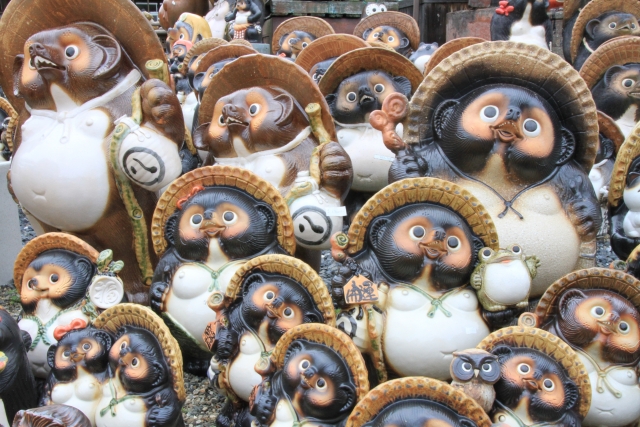News
2023.06.14
Columns
Shigaraki Ware:Simple Taste that Attracts People
Shigaraki ware (Shigaraki yaki) is a pottery produced mainly in Shigaraki, Koka City, Shiga Prefecture, and is counted as one of the six ancient kilns of Japan. Today, raccoon dog ornaments are generally well-known, but originally it developed from the production of tea pottery. In this column, we will introduce the history and characteristics of Shigaraki ware.

Table of Contents
1. History: Representative Specialty Products that Change with the Times
_1-1. Beginning
_1-2. Tea Set
_1-3. Large Pottery
_1-4. Raccoon Dog Figurine
2. Features: Unique Texture, Rustic Taste
3. Conclusion
History : Representative Specialty Products that Change with the Times
Beginning
There are two theories about when Shigaraki ware began to be made. The first is the Nara period. There is a theory that Emperor Shomu established Shigaraki as his capital, and that the Nunome tile used in the palace were made in this area. However, since no trace of the kiln that fired it has been found, it is said that there is insufficient evidence as to when production began. The second is the late Kamakura period. Since kiln sites and excavated items from this period have been discovered, it is believed that the late Kamakura period is more appropriate in terms of the period of establishment.
Tea Set
In the Muromachi period, Kyoto and Nara was the center place of the tea ceremony. Shigaraki is close to these cities and good soil can be obtained, so excellent potters gathered and the production of tea utensils became active. During this period when the tea ceremony was developing, Shigaraki ware was able to develop greatly due to the favorable conditions of this location. The high-quality tea utensils made from high-quality soil were recognized by the Tokugawa Shogunate in the Edo period, and were even commissioned to produce tea jars for presentation. After that, the production of tea jars in Shigaraki continued until the Taisho period. In this way, Shigaraki ware has followed the path of development along with the tea ceremony since the Muromachi period.
Large Pottery
From the Edo period, with the advent of climbing kilns, large-scale pottery making also get popular. The potter’s clay, which is a mixture of Kibushi clay, Mitsuchi clay, and Gairome clay found in Shigaraki, was strong and suitable for making large pottery such as water jars and pots. The advent of climbing kilns made it possible to mass-produce products, and together with the development of commerce during this period, Shigaraki became even more famous as a pottery production area.
The production of braziers began in the Meiji period, and after the Second World War, they accounted for 90% of the domestic market share. The brazier of Shigaraki ware, which has excellent fire resistance, continued as a major industry in Shigaraki until the 1950s when electric and gas heating appliances became widespread. Also, after entering the Showa era, kiln-changing glazes such as sea cucumber glazes began to be used.
Raccoon Dog Figurine
The image of “Shigaraki ware = raccoon dog” is established in many people now, but its history is relatively short, and it was not until the Showa era that it was actively produced. Around the beginning of the Showa era, Tetsuzo Fujiwara, a potter who was active in Shigaraki at the time, began to make raccoon dog figurines. When Emperor Showa visited Shigaraki, he was welcomed by arranging a large number of raccoon dog figurines. With the poetry that Emperor Showa wrote, the raccoon dog figurine spread throughout the country through newspapers and other media. Furthermore, the shape of Shigaraki ware raccoon dog figurines has been widely believed to have eight virtues, such as prosperity in business, improvement in financial fortune, and inviting good fortune.
Features: Unique Texture, Rustic Taste
The finish of Shigaraki ware is decisively different from that of pottery from other production areas.
・Soil that is white and mixed with many pebbles.
・Scarlet brown marks that occur during firing.
・Natural glaze with a green or pale yellow color.
・Milky white spots formed by dissolving feldspar grains.
This finish is due to the soil that has fully received the blessings of Lake Biwa. About 400,000 years ago, the land where Shigaraki is today was part of Lake Biwa. Earth and sand, remains of animals and plants accumulated here, and weathered granite and rhyolite flowed in, creating a clay soil suitable for pottery. When this clay is fired as it is without applying a glaze, a chemical reaction takes place, resulting in a pink or scarlet pottery. This texture, which is characterized by the contrast between the whitishness of Shigaraki clay and the scarlet color of the baked clay, is called “Kamaaji”.
In this way, the simple taste created by the earth and fire is the “wabi” and “sabi” in the world of tea ceremony, and was loved by many tea masters.
Conclusion
Since the Muromachi period, Shigaraki ware has developed greatly with the times, starting with tea utensils, then producing large pottery and raccoon dog figurines. In addition, the finish, such as the contrast of scarlet on the white clay surface and the natural green glaze, which can be made by firing the clay that has been richly blessed by Lake Biwa, has a rustic taste that is different from pottery from other production areas. I’ve been fascinated.
Imoto Sangyo handles a wide variety of Japanese ceramics and pottery. For more information, please see the “Goods & Cases” page.
(Reference)
Shigaraki Tourism Association
Shigaraki Ceramic Industrial Cooperatives
Genereal Website of Pottery
Category
Archive

